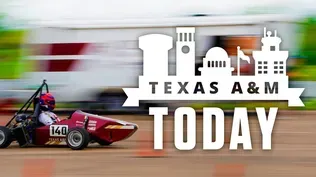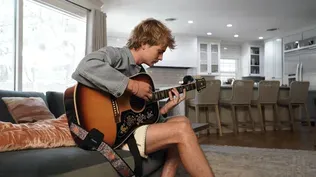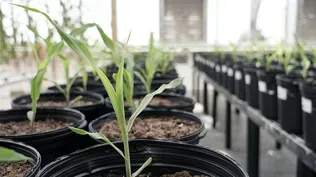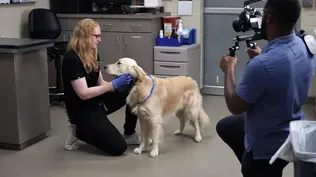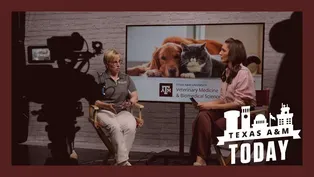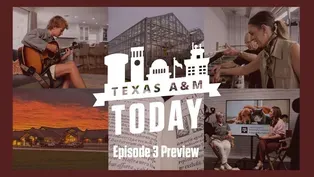
Ep. 3 - Supporting Life at Texas A&M
Season 2 Episode 3 | 29m 29sVideo has Closed Captions
See how Aggies work to improve the lives of humans and animals every day.
In Episode 3, see how Aggies work to support life every day. Learn about the ever-changing music scene in Bryan-College Station. Watch how A&M conducts research to improve fish genetics and check out robots that can enhance our plantlife. See how the Vet School continues to make impacts on our community, and watch a rapid-fire Q&A with an Aggie veterinarian discussing pet care myths and facts.
Problems with Closed Captions? Closed Captioning Feedback
Problems with Closed Captions? Closed Captioning Feedback
Texas A&M Today is a local public television program presented by KAMU

Ep. 3 - Supporting Life at Texas A&M
Season 2 Episode 3 | 29m 29sVideo has Closed Captions
In Episode 3, see how Aggies work to support life every day. Learn about the ever-changing music scene in Bryan-College Station. Watch how A&M conducts research to improve fish genetics and check out robots that can enhance our plantlife. See how the Vet School continues to make impacts on our community, and watch a rapid-fire Q&A with an Aggie veterinarian discussing pet care myths and facts.
Problems with Closed Captions? Closed Captioning Feedback
How to Watch Texas A&M Today
Texas A&M Today is available to stream on pbs.org and the free PBS App, available on iPhone, Apple TV, Android TV, Android smartphones, Amazon Fire TV, Amazon Fire Tablet, Roku, Samsung Smart TV, and Vizio.
Providing Support for PBS.org
Learn Moreabout PBS online sponsorshipThe Texas A&M Today Show is made possible thanks to Grow College Station.
Howdy, From Texas A&M.
We're on a mission to find the best and brightest at Texas A&M.
Taking you behind the scenes of one of the nation's largest universities.
In today's episode, we dive into a few ways Aggies support human and animal life every day.
Students are seeing really the breadth of veterinary care.
Humans have been breeding plants to meet our needs for generations.
None of that would exist without that house, without this experience, without going to A&M specifically.
And our goal is to help produce things more efficiently and in a more cost effective manner.
Welcome to campus.
Welcome to Texas A&M today.
Howdy, I'm your host, Chelsea Reber.
Today I'm exploring the veterinary and biomedical education complex.
We'll have more on the work done in this area of campus in a few moments.
Sometimes new ideas are a remix of past ideas.
Bryan College Station used to be a tour stop for some of the greatest musical acts of the last century.
That's not the case anymore, but the music scene is growing once again, thanks to Aggie musicians like Surfaces and big events drawing talent back to the area.
There's nothing quite like seeing a great concert.
Same could be said for a great play or great performance of any kind.
For me, it was always music to see performers that you admire and to share that room with them for just a little while, to me, is a is a special thing.
There are lots of books about Texas A&M and all the wonderful things that go along with it, but there wasn't one about concerts and I thought, This is a story that needs to be told, and I'd really like to be the one who tells it and shares these things with all these people that I talked to.
My book, Live from Aggie Land.
Legendary Performances in the Brazos Valley was published in 2017 by the Texas A&M University Press.
I'm always eager to hear their, you know, memories of those events.
And I think being there at a legendary show means something.
It means something to have been here for the last moment of Garth Brooks world tour.
And it means something to be here to see Elvis when he wasn't yet known as Elvis, Johnny Cash, Nat King Cole and Willie Nelson and R.E.M.
and the Ramones and all of these.
All these names.
It's an impressive history.
I think it adds to sort of the cultural fabric here.
I first started working with Elton John.
One of the first things he said he, like, knew where I was going to college.
He's like, oh you're Collin you go to Texas A&M, right?
I'm like, yeah, like, how do you know that?
And he was like, You're still going there right?
I was like, Yeah, I'm in my last semester, it's COVID semester.
but like, I'm still attending yeah.
And he goes, oh yeah one of my very first concerts was in College Station in the States.
I was like, that's crazy.
All these like country, like goats and all of these, like, really famous musicians, kind of like, got their start like in College Station through these, like, venues and stuff.
And it's like, it's cool to see the historical significance of music.
Kind of get rubbed off on College Station Surfaces was something I started in high school.
I started watching like a bunch of like MTV.
And I was like, Man, I really wonder how this song is like, made.
Like, how do people make songs?
Forrest is also doing the same thing at Baylor, just like making music, throwing it on SoundCloud, you know, just for the fun of it.
So he found one of the EPS I just released in 2016 and he liked what I was doing.
And then I checked out his stuff and I was like, I like what you're doing.
Like, we should like, you should drive in or I can drive in to you and like, you know, to see if we can collaborate and stuff.
We recorded like four or five songs in like a weekend.
And at that point it was like more than just a collaboration.
I was like, Would you just want to step in and be the male lead of Surfaces?
You know, help me write songs and produce and stuff and it's kind of just, you know, history from there.
I lived in this little blue house on Montclair in College Station.
I lived in the middle bedroom, So it was like, there was no windows in there And we would put the mic in the closet, we'd shove the clothes left and right, just stick the mic in the middle.
And then Forrest would go in there and just close the door with all my clothes in there.
And we were just recording all the songs, or pretty much all the songs for the second album in that little room.
The song that really took off for us was Sunday Best I mean, over a very short span, the world kind of took it by storm and it went triple platinum, and I think it's over like two or 3 billion streams, which is like kind of unfathomable to think about.
I pass that house and I'm like, man, the amount of memories that are in that house and like, that album wouldn't have got made if it wasn't for that house, that song or all those songs, like we probably recorded like 20, 30 songs in the house, like none of that would exist without that house, without this experience, without me going to college, going to A&M specifically.
I think it's great that current students are in bands and playing around town, and it's great that there are venues that focus on local music and not just bringing in sort of regional acts.
That's a big part of of what makes a local music scene happen.
It's not just Garth Brooks coming to town, it's shows that happen every week or weekend.
Local music scenes are important because they're just so much fun, especially when it's any new, original band making up something new.
It's the most fun for me to see.
Like how they present themselves and how they sound and what is the drummer doing?
It's a little bit different.
or what's the guitarist doing?
The College Station music scene is very diverse.
You have us playing rock music.
There's a lot of indie artists, there's country, there's everything.
Every year, new people coming in.
The student population is always getting bigger.
People from different places coming and bringing their influences.
So every year you see like an influx of just like new bands starting.
We all met through Fish camp.
I posted on Snapchat Who wants to start a band?
Seems cool at the time I was a kid bassist, so I only had a year of experience under my belt.
I didn't really know what I was getting myself into, but it's really worked out since then.
What separates Kitsch is that the concerts are kind of a whole experience.
You have to actually put in energy and we'll give it back.
It's just it's very high energy for all of us.
We all get off stage and we're sweating like crazy because we just want to give everything we got.
You walk around on campus now and you see random people, people I've never met wearing our merch and I'm like, Wow, Like, that means so much to us having a community that backs us, that brought us to this point where we can get those bigger shows.
We can start playing with these bigger names because ultimately our goal is not to be a student band.
We want to get out there, get out of our hometown and try to make a difference, try to get our music in people's ears, try to have people in other towns and other countries even listen to our stuff.
And that starts here in College Station.
Aggieland is a special kind of place.
Artists make memories here.
Garth Brooks remembered his positive experience when he played here in the early nineties, when he was looking for a place to end his world tour in 1998.
The friendliness of of Aggieland means a lot and means that those artists come back.
We can go back and we just look back at who was here in the past and what did they bring and what was that like.
It is fun to look at that and be like, oh we can do that.
Like, if we did it then, we can do it now.
Reed is a great test site for them to just kinda get a feel of what it's going to really be like in a larger arena and as they move on.
The sheer number of seats in Kyle Field are what really set it apart and have made it something that people are really kind of eyeballing right now and like, what about doing a stadium tour?
And there's so many stadium tours currently going around that we're starting to hear a little bit of buzz about Kyle Field and what if we did one at Kyle Field?
We're all working towards being becoming more of a music scene, entertainment scene here in Bryan College Station, all the music that's happening around and outside of Texas A&M but in the community is very exciting because it just means we're vibrant and they're selling tickets.
And our community wants it.
We're laying the groundwork.
We will see more special events.
We're going to see more entertainment on this campus.
Just be patient because it's coming.
Collins work recently made headlines in Aggieland.
He created the Aggie football team's new walk out song, which debuted this season.
If you want to read more about Collin, head to the Texas A&M Today Show page on our website.
He shared more about his musical journey and what he looks for in a song.
As overfishing from the world's oceans remains a concern, how can the fishing industry provide enough fish to meet global demand?
By looking inland with help from researchers, including here at Texas A&M.
Texas A&M uses the land surrounding the Brazos River for many agriculture projects, including improving the crops we use and eat.
But the improvements don't stop at plants, the farm land is also home to this 36 ponds for developing better fish.
We have thousands of fish at the facility.
It's to support aquaculture production in the state of Texas, but it goes much beyond the state.
Not all fish come from the ocean anymore, aquaculture facilities around the globe efficiently and sustainably raise fish for your plates and fishing rods.
But in the United States, we have a diverse industry where our goal is to help produce these fish more efficiently and in a more cost effective manner.
Catfish Oh yeah, I can see a couple here there they are.
Tilapia.
Oh my gosh, that feels so weird.
Delbert Gatlin and his team are supporting farmers and companies with research about America's most popular kinds of fish.
But a lot of times our initial research will be done indoors.
We gain insights.
We find discoveries that we want to test at a larger production scale.
The diet is the most expensive variable cost in aquaculture, so we do work to evaluate nutrient requirements of the fish to make sure that they are receiving what they need to meet their nutrient needs.
Going to put some feed in the water All right.
Let's see it.
See if they want to start eating I see a couple Yes.
There you go.
An added bonus.
They're training the next generation of fish researchers.
This facility has actually been in operation for 50 years.
And the graduate students I have 60 plus graduates that are located all over the world that are working in research agencies or for private companies, for females, for commercial production facilities, and for federal agencies all over the United States.
And so it's been rewarding to have such a network of former students.
So next time you're out fishing, just remember Texas A&M experts help make it all possible.
And the booth does have students around.
They need to share their knowledge.
Well, it's it's my passion.
I really love what I do.
So it's a wonderful job.
If you are curious what a fish expert recommends for dinner, Dr. Gatlin says he has many favorites, including halibut, salmon and catfish.
But his all time favorite is bluefin tuna.
Robotic arms date back centuries.
Leonardo da Vinci created a robot that could wave its arms In 1495, 1769, saw a chess playing arm built for a Hapsburg Empress.
The first modern arm was made for spray painting in 1938, and robotic arms have been used on automotive assembly lines since the 1960s and in space since the 1980s.
But Texas A&M agrilife recently found a new purpose for the technology, and it could help change the game for our food supply.
Humans have been breeding plants to meet our needs for generations.
The College of Agriculture as a whole has a mission statement.
Feed more people.
We need to develop the technology to keep up with the food demands.
And so that's why we have to we have to have proprietary technologies and infrastructure that support that.
So that's where this facility gives the researchers an opportunity to develop that.
Most of these houses here are, we are replicating a summer afternoon, 14 hour days.
95 in the middle of the day.
I'm trying to recreate what's happening in the field indoors, year round.
Maybe the disease resistance is coming from the waxes that are on these plants.
I mean, if you look at this plant, maybe it's a little bit waxier.
You know, it's got a little more we call it bloom or wax level.
I am one of two corn breeders for the state of Texas.
My overarching goal is to increase the economic and environmental sustainability of agriculture.
The most effective way to do that is through plant breeding.
So genetically improving the crop.
We could really use this facility to do more of a deep dive into individual plants and look at how disease is affecting the plants.
Just like some of us, we're a lot more susceptible to COVID than others.
Some of those plants are much more susceptible to northern corn leaf blight or leaf rust.
Currently in many greenhouses here at Texas A&M.
You could walk in at any time and there will be an assembly line of students, grad students and undergrads with measuring tapes and scales, taking data.
The best that that team could do would be once a day.
With this technology, we could take those same data points probably up to six times a day without ever stopping, without even disturbing the plant.
We are the first one to use a robotic arm.
So in every other facility in the United States, the plant is taking to a photo booth and the data points are taken.
That limits the plant, how big it can be because the booth is only a certain size.
The second part of that, if you're disturbing that plant by moving it, the robotic arms help us because the most laborious part of what we do is in measuring things.
The robotic arms are set so that they can scan all these plants automatically.
We think we can get hundreds of measurements from those scans.
With this automated system, the barrier for each measurement is almost zero.
There's very little cost, both in terms of people's time or in terms of money.
These are the exact same arms that you're seeing on the assembly lines in our automotive industry.
A robotic arm is is very similar to a human arm and it has the same movements and motions that we do, but it doesn't get tired.
We can put any instrument that we see necessary on the end of that robotic arm to do a repeatable task over and over and over.
We develop artificial intelligence approaches to analyze images.
I'm able to merge my artificial intelligence knowledge with their plants in order for us to develop this useful product.
We can collect high resolution images and then from there we do some preprocessing to clean up the images dealing with some kind of artifacts or things that might not be well suited for the data.
The end products, we want to have some kind of like user interface, kind of like an app where people can, you know, take images from the facility here and they can say, I want to get the link to this plan or get some kind of useful information, or is there some kind of disease is present in the plant?
What we're trying to do is trying to mimic how we as humans see.
And so part of my work is trying to figure out how can we identify those interesting features, or information that we cue in as humans in order to let the A.I.
model know, okay, there might be some some issue with the plant.
I'm really excited to really have an impact because for me, I never just wanted to get stuck in the weeds or just doing research, but really doing research to make some meaningful impact for society as a whole.
We want to be able to leverage these A.I.
tools in order to achieve these goals that will be beneficial for our society.
We used to have to go to the office to check our emails.
Now we just pick up our phone and check our email.
It's the same thing with some of that data that these scientists are looking for.
If they could get that data faster, they can develop technologies faster.
Without the infrastructure, they cannot develop the technology that we're going to need in the future.
People want to work within an infrastructure that is high quality so they can focus on their research and not on where they're going to do their research.
Quality infrastructure drives quality research.
The next step at the facility is installing soil handling equipment so researchers can mix custom soils for their experiments.
Ultimately, if the facility is a success, you can expect to see more robot arms in greenhouses across the state.
Now it's time for an Aggie fact.
Because of A&M's world famous vet school.
We're home to more than 12,000 historic veterinary books and artifacts.
That includes three of the topics oldest and most famous writings.
Perhaps the most well-known is a book published in 1528.
It's the first printing of a book originally written on scrolls in the fifth century.
Other famous items include the first printed book on horses from 1511 and a manuscript about war horses from 1440.
Some of the best veterinary collections in the world have been sold to A&M, with sellers happily saying their books would be well cared for and still accessible to the public.
Pets are family and when they're hurt or sick, most of us will do anything for them.
And there's no better place in the state for veterinary care than Texas A&M.
For more than 100 years, Aggie veterinarians have handled the most specialized cases, treating your pets like their own.
Their reputation is far reaching.
And to keep it strong, improvements are on the way.
For many people, Texas A&M is known for its vet school.
When they think of Texas A&M, they think of the vet school.
And for many, many years we've been the only vet school in the state.
So our present hospital is 41 years old.
It was occupied, I think, first in 1982, at a time when 7000 patients a year were being presented for care at the hospital.
The hospital was really built for 1982.
It wasn't built for veterinary medicine in 2023.
We've grown six times and as you can imagine, the people that comes with that, we had two specialty services back then.
Medicine and surgery, and now we're up to 18 specialty services.
The hospital is everything from general practice that you would see with your personal pets.
And then when you need more advanced care, we have all the capabilities that you could possibly imagine.
We're a tertiary care facility, which means that they've seen their regular veterinarian, their general practitioner.
Then oftentimes they get referred out to a specialist.
And when that specialist is at a stopping point, then sometimes they come here for further care, things that they can't get anywhere else.
You know, so it's actually We're a huge state, 30 million people with and we only accept 180 graduates a year.
So the students that we get have had to jump through an enormous number of academic hoops and commitments to be able to get here.
So our students truly are extraordinary.
It's been wonderful to be able to have the caseload and kind of get primary hands on experience where I'm getting to do stuff and I'm still learning about it, reading all the appropriate textbooks and everything, but still getting that practical hands on experience.
Their day consists of receiving patients.
So we average about 70 to 100 appointments in this hospital a day.
And students are an integral part of that.
So they'll greet clients, they'll take histories, they'll do a preliminary physical exam on their patients, and then they'll come back and share that with the veterinarians and again, kind of refine and fine tune that plan to make sure that the students get good teaching value out of it.
Then the real magic actually happens, whether it's lab work or X-rays or a surgical procedure or diagnostic procedure.
The days are long and very busy.
But I think that we are very fortunate here to have a very busy caseload where we have a lot of exposure to a variety of cases.
We are still facing a lot of limitations.
You know, we often don't have enough exam rooms to accommodate our clients and our patients at at times.
And sometimes we're fighting over O.R.
space and everything like that.
We have a large number of residents and interns who are training to become specialists who will be heading out to provide advanced care themselves.
And so we really do have a very large impact on animal health and people's dependency on animals.
When we know how much people depend on the companionship of their animals at home.
And and we we like to think we provide advanced care, but with compassion.
I grew up in a house full of animals, like most people who want to be veterinarians.
And I had a little Barbie doctor play kit and I, instead of playing doctor on my parents, I played veterinarian on all of the household animals that we had.
I really loved working with animals and just the compassionate care that we can provide.
And plus, our patients are really precious.
It's I've heard clients say, gosh, they treated my dog like it was their own.
And I would say, yes, this they do.
And that's, I think, inherent in most of our veterinarians that that compassion this this is a member of of your family and it actually becomes a member of ours.
Texas needs this hospital because we are the only teaching hospital in the state of Texas.
We now have a new responsibility as a school of veterinary medicine and as a small animal teaching and research hospital, not just to be another specialist hospital, but to be the place in Texas and beyond.
In the southern region where patients with the most difficult problems are referred and where research driven patient care is provided.
The state sees the need, the university sees the need, donors see the need for this very unique project.
If you'd like to support the vision for the new Small Animal Teaching and Research hospital, head to the Texas A&M Today Show page on our website.
We've added a link where you can learn more about donating.
Next, we have a special Q&A with a Texas A&M veterinarian.
Today, I'm speaking with Dr. Lori Teller.
She's a clinical professor in the School of Veterinary Medicine and Biomedical Sciences.
And today she is going to set the record straight on some myths about pets.
Dr. Teller, thank you so much for being with us today.
I'm really happy to be here.
Thanks for having me.
All right.
Let's get into these myths and see what is true and what is false.
Dogs age seven years for every human year.
False.
So dogs age much more rapidly than we even thought.
We know at the end of their first year they're somewhere between an older teenager and a young adult.
And at the end of their second year, they're they're approaching early middle age.
And then after that, it slows down some and then it becomes dependent on the breed and the size of the dog.
So bigger dogs age much more quickly than our smaller breed dogs.
So the best thing to do is ask your veterinarian how old your dog would be in human years.
Cats always land on their feet.
False.
So there's such a thing as high rise syndrome.
And so cats are amazing.
They have what's called a riding reflex.
And because they're so flexible, they can twist when they fall.
But from certain heights, they can land on their sides or their backs and they can cause a lot of damage or even die.
So don't just trust that cat to land on its feet all the time.
So I hope this one is true because I talk to my dog all the time.
Dogs can understand a small amount of human language.
True.
So keep talking to your dog.
I agree.
They really kind of like the baby voice too.
Dogs can learn language up to about what a 14 month to two year old toddler could learn.
So they have a really good capacity for learning very simple language and understanding what you're saying to them.
Purring always means your cat is happy.
I wish so false Purring can mean your cat is happy, but it is also a self-soothing mechanism.
So cats that are in pain or anxious may purr to help soothe themselves.
Dogs mouths are clean.
False.
Dogs mouths are gross.
We're talking about animals that will clean out a litter box for you that eat anything out of the yard.
Dogs mouths are full of bacteria, just like our mouths.
And it's a different population of bacteria.
So your dog can give you a big slurp on the cheek and you're going to be fine, but they're not clean.
Dr. Lori Teller, thank you so much for joining us today.
Thanks for having me.
It's been great.
You can watch the full version of our conversation on our website.
That's it for this episode of Texas A&M today.
You can watch all past episodes on PBS.org or our YouTube channel.
Gig'em The Texas A&M Today Show is made possible thanks to Grow College Station.
Extended Cut: Pet Mythbusters Q&A
Video has Closed Captions
Watch Chelsea’s interview with Dr. Lori Teller as they discuss pet care myths and facts. (10m 54s)
Providing Support for PBS.org
Learn Moreabout PBS online sponsorshipSupport for PBS provided by:
Texas A&M Today is a local public television program presented by KAMU
